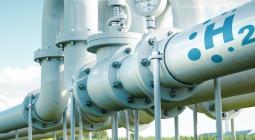Hydrogen – Tale of the future or a real game changer?

In light of the objective of achieving a climate-neutral EU by 2050, as reflected in legislative proposals included in the Fit for 55 package and REPowerEU, increasing hydrogen production and use will be essential in the coming years.
Patryk Demski is the Vice President of the Management Board for Strategy and Development of the TAURON, PKEE representative.
As stated in the EU Hydrogen Strategy, hydrogen has been enjoying renewed and rapidly growing attention in Europe and around the world. It can be used as a feedstock, a fuel, or an energy carrier and storage, and has many possible applications across the industry, transport, power, and buildings sectors. It thus offers a solution to decarbonise industrial processes and economic sectors where reducing carbon emissions is both urgent and hard to achieve. What we need to remember is that commitments at the EU level mean commitments for businesses.
Are energy companies ready to enter the hydrogen market?
Tauron, as a company with ambitious goals for the future, plans to operate on the hydrogen market. According to our strategy for the years 2022-2030 (with an outlook until 2050) – ‘Tauron’s Green Turn’, in 2030 we are planning to have 3,7 GW in renewables installed capacity (compared to 0,6 GW in 2021), and this means an increase of RES capacity by 520%.
It will give 78% of the installed capacity to renewables. In the area of hydrogen, in the nearest months and years, we will be seeking economically justified green hydrogen production options as well as creating and developing demand-side solutions related to green hydrogen, green ammonia, and biomethane. The strategy is very important, but the experience that we already have is of crucial importance when we think about entering the hydrogen market.
Our portfolio includes, e.g. the InnoEnergy „CO2-SNG” project, and Tauron Inwestycje, as a leader of a Polish-French consortium, successfully carried out the InnoEnergy „CO2-SNG” project in 2015-2019, which involved the construction of a pilot-scale Power-to-gas installation that combined hydrogen and CO2 captured from power plant flue gases into synthetic natural gas (SNG), which has been successfully used as an alternative fuel to power a car. The installation works in a real industrial environment and is fully integrated with the existing power plant infrastructure. The CO2-SNG plant is one of the first in the world to use this kind of a methanation reactor.
The experience obtained from pilot-scale research projects allowed the company to begin developing projects up-scaled to a large, fully commercial industrial scale. Tauron Inwestycje’s proposal for the IPCEI on Hydrogen is the “Hydrogen Poland” (HP) initiative, which consists of two projects, with a combined electrolysis capacity of 36 MWe. The aim of this project is to establish a consortium combining scientific and industrial potential to cover the whole hydrogen value chain with their competences. The green hydrogen will then be used mostly, but not only, for bus fleets and will help reduce emissions in Polish cities.
Clear regulations and financing rules as pillars of hydrogen market development
What we need now is acceleration to keep up with the rest of the world, including the United States. We have ambitious goals when it comes to renewable hydrogen, but there is still no certainty of whether the market is able to meet them. Too long legislative works (e.g. we still do not have clear regulations on various types and colours of hydrogen), too complicated regulations, and a lack of funds may result in delayed hydrogen market development.
Hydrogen should, at the first stage, be financed with a large share of state aid in various process configurations. The paths to hydrogen development should not be closed by fragmenting the process. We need a completely new, cross-sectoral approach to hydrogen, and regulations at every stage (each mini-process) will not lead us to the effective use of hydrogen potential.
European Hydrogen Bank
The European Hydrogen Bank (EHB) isa very good and long-awaited initiative. For sure, it can become a mechanism that will allow many companies to get started in the hydrogen market. What the hydrogen sector needs now is concrete public support before it can operate in a fully competitive market. Public financing, both through EU financial instruments and state aid, will play an important role in stimulating private investment.
The EHB, as the main instrument for managing the construction of the hydrogen market and the created auction systems for the internal market and hydrogen imports, must be well designed, well implemented and monitored so that it can be appropriately modified, if necessary. Key points from our perspective on the EHB: firstly, length of support: fixed premium support for only 10 years does not seem to be sufficient; secondly, budget: the level of support in the first pilot auction, EUR 800 million, could be perceived as a very low budget; the European Hydrogen Bank itself is not a new creation, it will be financed from the already functioning Innovation Fund – that is why increasing the budget for the auction from the EU side, not from member states, should be taken into consideration; thirdly: distribution of resources: many projects might not receive funding from the Innovation Fund budget, and there will be a need to engage a lot of support from Member States. Equal allocation and distribution of resources among member states, so as not to favour any one of them, should be taken into consideration.
Pillars of hydrogen market development
What we see as key factors to fully using the potential of hydrogen are: good and clear regulations that ensure regulatory certainty for businesses; dedicated funds, both at EU and national levels; a good regulatory framework for state aid, including facilitations for the hydrogen market; and clarity on the matter of different/various “colours” of hydrogen. Other solutions should also be taken into consideration, such as, for instance, regulatory sandboxes, which would allow the development, testing, and validation of new hydrogen technologies in a controlled environment before they are placed on the market.
From the perspective of the energy sector, we are looking first and foremost at the needs of industry. We want to act so as to make sure that hydrogen production makes sense and makes a real contribution to the decarbonisation and transformation of the economy.
cover photo:[TAURON]





